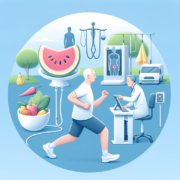As our bodies age, various factors like wear and tear, chronic conditions, and reduced regenerative abilities can contribute to pain. While pain management is a crucial aspect of maintaining a good quality of life, many individuals prefer to explore natural and non-pharmacological approaches. In this comprehensive guide, we will delve into the types of pain experienced in aging bodies, the science behind natural pain management techniques, and practical strategies to alleviate pain and enhance well-being.
Introduction
Pain is a complex and subjective experience that can affect individuals differently. Aging bodies are particularly prone to various types of pain, including:
- Musculoskeletal Pain: Arthritis, joint pain, and muscle stiffness are common in older adults.
- Neuropathic Pain: Conditions like diabetic neuropathy and shingles can cause nerve pain.
- Back Pain: Degenerative changes in the spine can lead to chronic back pain.
- Headaches and Migraines: These can become more frequent as individuals age.
- Post-Surgery Pain: Recovery from surgeries can result in acute or chronic pain.
- Pain from Chronic Conditions: Conditions like fibromyalgia or osteoporosis can lead to persistent pain.
Natural Pain Management Techniques
Natural pain management techniques are non-pharmacological approaches that aim to alleviate pain and improve overall well-being. These techniques are often preferred by individuals who want to avoid or reduce the use of medications due to concerns about side effects or dependency. Here are some evidence-based natural pain management strategies:
1. Physical Activity
- Engaging in regular, low-impact exercises like walking, swimming, or tai chi can improve joint flexibility, muscle strength, and overall pain management.
2. Heat and Cold Therapy
- Applying heat or cold packs to painful areas can help reduce inflammation, soothe sore muscles, and alleviate pain.
3. Massage Therapy
- Regular massages can relax tense muscles, improve circulation, and provide relief from musculoskeletal pain.
4. Acupuncture
- Acupuncture involves inserting thin needles into specific points on the body to stimulate natural pain-relieving mechanisms.
5. Mind-Body Practices
- Techniques like mindfulness meditation, deep breathing, and yoga can help manage pain by reducing stress and improving pain tolerance.
6. Dietary Changes
- An anti-inflammatory diet rich in fruits, vegetables, whole grains, and omega-3 fatty acids can help reduce inflammation and alleviate pain.
7. Herbal Remedies
- Some herbs and supplements, such as turmeric, ginger, and glucosamine, have shown promise in reducing pain and inflammation.
8. Physical Therapy
- Working with a physical therapist can help individuals develop customized exercise and stretching routines to manage pain.
9. Cognitive Behavioral Therapy (CBT)
- CBT can be beneficial for individuals with chronic pain, as it helps change negative thought patterns and develop coping strategies.
Consultation with Healthcare Providers
It’s essential to consult with healthcare providers, such as primary care physicians, pain specialists, or physical therapists, before starting any natural pain management techniques, especially if you have underlying medical conditions or are taking medications. They can provide guidance, tailor recommendations to your specific needs, and ensure that your chosen strategies are safe and effective.
Conclusion
Natural pain management techniques offer a holistic and non-invasive approach to alleviating pain and improving the overall quality of life for aging bodies. By incorporating these evidence-based strategies into your daily routine and working closely with healthcare professionals, you can effectively manage pain, enhance your well-being, and continue to lead an active and fulfilling life as you age. Remember that pain management is a personalized journey, and finding the right combination of techniques may require patience and experimentation.
-

1 Understanding and Managing Lower Back Pain in Older Age
-

2 Age and Agility: Staying Active to Prevent Falls
-

3 Healthy Eating for Heart Health in Older Adults
-

4 The Benefits of Strength Training for Seniors: Building a Stronger and Healthier Tomorrow
-

5 Aging and Digestive Health: Keeping Your Gut Healthy
-

6 Building a Brain-Healthy Diet: Foods to Focus On
-

7 Maintaining Mobility and Flexibility in Your Later Years
-

8 Planning for Retirement: Health and Wellness Considerations
-

9 Preventive Measures Against Common Cancers After 45
-

10 Mastering the Art of Healthy Aging: Tips for Staying Young at Heart


